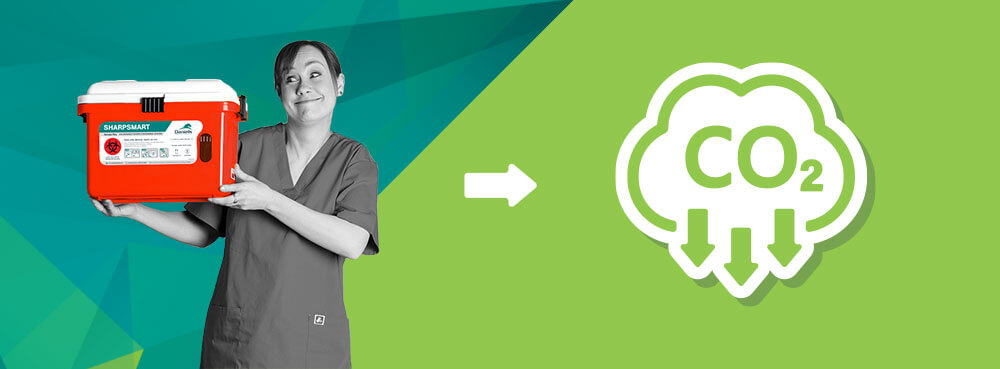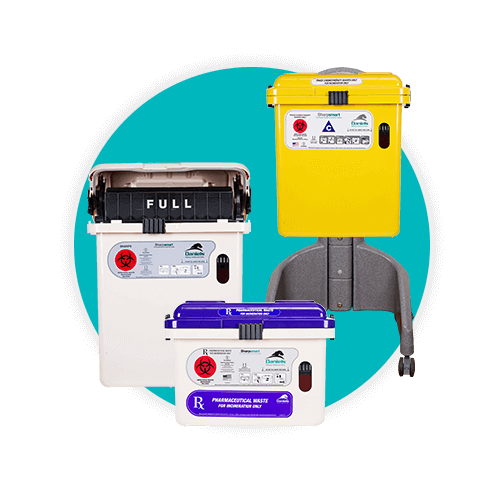The Critical Role Healthcare Waste Management Can Play in Your Sustainability Initiatives

As healthcare facilities continue to gain greater awareness of their role in driving sustainability, many have begun to adopt sustainability initiatives to drive their shift toward a greener way of operating. Initiatives such as the White House’s Health Sector Climate Pledge aim to help the healthcare sector reduce its role in US greenhouse gas emissions by cutting emissions and waste. These sustainability initiatives, more often than not, use benchmarks and metrics designed to help track and report their progress toward reaching these goals.
As facilities strive to meet these targets, many have focused on energy efficiency and transportation, which though crucial, often lead to overlooking what often is the biggest barrier healthcare facilities face to achieving sustainability, which is waste. Hospitals alone produce more than 5 million tons of waste annually, and according to the World Health Organization, only slightly more than half of facilities have adequate systems in place to handle it.
This leaves a significant amount of room for improvement in several key areas of sustainability by focusing on improved waste management. For example, reduced greenhouse gas emissions in transporting waste for disposal, more waste diverted from landfills, and less energy wasted on unnecessary processing due to misclassified waste. These improvements can often mean the difference in achieving waste management goals, and here we will take a closer look at how.
TOPICS WE WILL COVER:
1 / How Reusable Medical Waste Containers Contribute to Key Sustainability Targets
2 / How Daniels Reusable Containers Can Help
How Reusable Medical Waste Containers Contribute To Key Sustainability Targets
Healthcare facilities have increasingly set sustainability targets in key areas and have created corresponding benchmarks to work toward these goals. Some of these key areas include greenhouse gas emissions and waste generation. Reusable medical waste containers can play a key and significant role in helping healthcare facilities reach their targeted sustainability metrics, and here is how.
Greenhouse Gas Emissions
The healthcare sector is one of the largest sources of greenhouse gas (ghg) emissions in the US, accounting for approximately 8.5% of total US ghg emissions in 2018. As a result, a considerable amount of attention has been paid to reducing the healthcare output of greenhouse gasses, and initiatives such as the federal Health Sector Climate Pledge have resulted in goals such as cutting emissions by 50% by 2030.
These are high goals to reach, with healthcare producing approximately two gigatons of CO2, but one of the most significant differences a facility may be able to make is in changing what it throws out. Studies have shown that the largest share of greenhouse gasses produced by healthcare originate from its supply chains.
Unlike changes that depend solely on staff behavior, changes in purchasing and disposal can have an immediate and significant impact on sustainability and greenhouse gas emissions. One of the biggest improvements that facilities can make toward reducing their intake and disposal of materials is employing reusable medical waste containers.
A study of one 1,100-bed facility found that by converting to reusable sharps containers, it reduced its greenhouse gas emissions by 162.4 metric tonnes of carbon dioxide equivalents (MTCO2eq). This was a 65.3% reduction in CO2eq over disposable containers and a significant addition to any sustainability initiative.
Waste Reductions
Another focus of most sustainability initiatives is waste reduction, and this is another area in which reusable medical waste containers offer enormous benefits. Healthcare facilities, particularly acute care, where patients require intense, short-term treatment, produce a vast amount of medical waste.
Most traditional disposable methods use multiple layers of packaging, including plastic bags and cardboard liners, to transport waste, and when they do, they need to dispose of this packaging as well. This produces vast amounts of cardboard and plastic waste, which ends up in landfills or incinerators.
By using reusable containers instead, facilities can completely divert this waste from the waste stream. For example, the same study of a 1,100-bed facility saw that switching to reusable sharps containers eliminated 50.2 metric tons of plastic and 8.1 metric tons of cardboard waste.

Many similar studies have shown similar benefits with immense waste reductions through diverting millions of tons of plastic and cardboard that would otherwise end up in a landfill. Again, this is a significant step towards meeting any sustainability initiative.
How Daniels Reusable Containers Can Help
Daniels provides not only high-quality reusable containers certified to 500 uses but a holistic approach to waste reduction that not only provides sustainability but increased efficiency, compliance with all regulatory requirements, and record-breaking improvements to safety. Daniels Sharpsmart containers have been approved to both ISO 23907-2:2019 and UN3291 standards and have been shown to meet the same rigorous standards on the final use as they did on the first.
Further, the Daniels process provides a tailored solution for each and every facility that optimizes its effect on safety, sustainability, and effectiveness. This is followed by tracking and reporting the effect they have on waste reduction, which enables tracking for the purposes of sustainability benchmarks.
This not only brings facilities measurable improvements in sustainability and the incredible increase in safety that has brought the largest reduction in needlestick injuries ever recorded but also a high degree of savings due to the long lifecycle of each reusable container. Each Sharpsmart container has an average lifecycle of more than 40 years.
Daniels reusable containers come in a wide range of sizes for all of a healthcare facility’s medical waste streams, including medicinal and non-medicinal sharp, pharmaceutical, cytotoxic, hazardous, and surgical wastes. Each container is color-coded to clearly communicate which type of waste it is designed to contain. These features help to ensure the correct classification of waste streams minimizing inefficient misclassification of waste and excessive labor in exchanging containers.
As the healthcare industry continues to work toward improving its environmental responsibility and sustainability, finding innovative solutions to the continuous creation of medical waste will become increasingly important. Daniels reusable medical waste containers play a crucial role in helping healthcare facilities meet their sustainability initiatives with proven benefits. Ready to learn more? Daniels can help tailor a waste collection and disposal program to meet the needs of your specific facility. Reach out to learn more about our sustainable waste solutions.
Let's Talk!
Your time is valuable, and we don’t want to play hard to get. You can either phone us directly on the details listed on our contact page, or feel free to fill out this short form and one of our team members will get back to you as quickly as possible.
